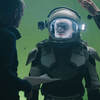The Power of Music: How Sound Influences your Film
Creating an impactful film isn't just about visuals. Learn how your soundtrack matters to your storytelling.
It’s easy for us as filmmakers (particularly of the independent variety) to spend countless hours planning, storyboarding, shooting, directing, perfecting a shot, compositing, color grading, splicing, and rendering out our finished work. You have a vision - and you’re eager to bring that vision to life.
In the media-saturated age in which we live, most everyone would probably identify as a “visual person,” meaning they are most engaged within the framework of a visual context. But what about when you don’t want your audience to simply see something - you want them to feel it?

The Power of Nostalgia
When I was seven years old, my mind was completely blown, as I watched Jurassic Park for the first time with my dad in our basement, in the fall of 1994. I’d never experienced anything like it, and Jurassic Park not only prompted my passion for filmmaking, but also my love of music.
I remember getting completely lost in the scene where Sam Neill’s character, Dr. Alan Grant, climbed up in the hulking banyan tree with Lex and Tim, while they quietly watched the brachiosaurs sing off in the distance, beneath the setting sun. A somber melody begins to play, as the characters slowly drift off to sleep, in what is perhaps my most favorite movie scene of all time. I can still remember every note of John Williams’ score during that scene, as well as almost every note throughout the entire film, after having watched it countless times over the years.
While that was a fond memory of my childhood, it was specifically imprinted on my mind most likely due to the combination of visual and aural stimuli, that automatically makes me feel good every time I think of Jurassic Park, or hear those familiar notes. There are other movies that have had a similar impact on my mind over the years, and the common denominator in all of them is a memorable score that made an emotional connection with me, the viewer. Music alone wouldn’t have been as impactful, visuals alone wouldn’t have been as impactful. But when the two reach a perfect balance, it can be amazing. I think we all want to make films like that, that leave a meaningful, lasting impression on our audience.
What’s Changed?
Think of Star Wars. Think of Indiana Jones. Think of Back to the Future, or Inception. It seems like just about every major motion picture, up until the last decade or so, had some type of uniquely distinguishing melody or theme that engrained itself into the identity of the movie. In the case of the original Star Wars trilogy, there are recurring musical themes for villains, for heroes, for the opening and closing titles...and it masterfully culminates in establishing a distinct feeling that impacts individual scenes, as well as the overall trilogy.
As more and more movies are released each year, I have come to agree with many reviews from critics and audiences alike, who complain that many modern movies just don’t feel as memorable or as special as the previous films mentioned.
Generally speaking, the focus on original music in films appears to be dwindling, and it seems reasonable to attribute this lack of memorability to the lack of emphasis on a proper score. It could be because more filmmakers are choosing to go with stock music, which can be notorious for being too generic, too safe, and even sometimes overused. But even when big-budget movies have composers these days, it would appear that they often aren’t writing music in a way that is compelling, or memorable to many people - limiting the overall impact the movie could have had on its audience. It could be a lack of collaboration between the filmmakers and the composers to work together and build a palpable atmosphere to the movie, as much of today’s industry is compartmentalized and siloed off.
Why Filmmakers Should Care About Music
Music generally gets the least amount of attention in today’s filmmaking industry, and it isn’t difficult to see why. Music is invisible, and visual effects is about the visible! Plus, not everyone is musically-inclined. Many artists get so wrapped up in the logistics of production that music becomes low on their priority lists.
Remember, however, that as a filmmaker you are trying to create an effect on your audience. Therefore, it's important to take some time to give serious consideration to the music in your project.

Your Audience Should Feel Your Story
You can impact your audience visually in what you show, and you can impact them audibly in what you let them hear. But when you can harmonize the visuals with sound in a meaningful way, that’s the moment your audience goes from simply seeing and hearing, to actually feeling. And isn’t getting the audience emotionally invested in your story the goal of every filmmaker? So let’s discuss what “harmonizing the visuals with sound in a meaningful way” could mean to you, in a practical sense.
Choosing the Right Soundtrack
It’s easy to find a random stock music track that sounds cool. But don’t let the appeal of the song to your musical tastes supersede the importance of carefully selecting which music actually belongs in your film.
What is the Purpose of Music in Your Project?
First consider, what is the purpose of music in your project? Are you using it to set a tone that is synergistic with the content of each scene? Think of the undercurrent you can conjure with the right music dynamic, as your scene evolves.
For example, a lot of heist scenes in movies begin with a subtle music bed that gradually escalates as the tension ratchets up. The music could even start with something as simple as a ticking watch. This draws the viewer in at the beginning of the scene in an attempt to audibly identify how the slowly-building music is changing as the scene progresses. The bank robbers put on their masks in a van, as they approach the bank. They rush out of their vehicle, and into the lobby of the building. Eventually, a gunshot is fired into the air, and chaos ensues - both visually, and audibly within the swelling musical score, while bystanders frantically scramble away from the bank robbers.
Could a scene like that bank heist example be effective without music? Sure. The aural emphasis could be entirely on foley - the sound effects of clips being loaded into weapons, footsteps approaching the building, thumping heartbeats, and heavy breathing. It could even be effective in complete silence, depending on the context of the scene. But the tricky question you need to ask yourself as you’re making your project is this: would your scene be more or less effective with music?

In the film industry, we have access to color palettes, formats, protocols, guidelines, and best practices for just about everything. However, when it comes to music, it’s not always that clear-cut. You will ultimately have to be the one to make the call on whether or not your scene would be better off with music. Sometimes, even silence or just ambient sounds of the scene carry more weight than music could in that moment. This is something you need to always be mindful of during the production process.
Determine the Right Amount of Music
Sometimes there may be too much or too little music in your scene. You definitely don’t want it to feel empty, but you also don’t want music to overpower the dialogue, or message of your scene. Your music selection needs to be carefully considered, because if your only source of music is choosing from a stock library, you may have a dozen options that would fit the scene. However, you need to discover for yourself which one fits the scene best.

Think About Music in Pre-Viz
If you’re limited to a stock library of music, it might be helpful to incorporate your music planning into your pre-visualization workflow. Instead of shooting first, then finding audio to pair your footage with later, take a hard look at your pre-production storyboard, or even just the script, focusing on what type of feeling you’d like to achieve with each scene. Then, dive in to your stock music library, and download your favorite tracks that might contribute to creating that feeling.
Once you hone in on your favorite track for a particular scene, write the song’s title down on the script or storyboard, then shoot the scene with that track specifically in mind. Play the track out loud, or through headphones on set, immersing yourself in the vibe of it. You can even plan out visual actions on set, based on musical cues from the song, such as a knife jab at a trumpet flare, a car door slamming or gun cocking at a brief pause, etc. Collaborate with your cast and crew to generate ideas for incorporating your music even further into the DNA of the scene.
A great example of the effectiveness of choreographing visual cues to go along with musical ones, is the top-notch intro to “Batman: The Animated Series.” First, watch this clip with the audio completely turned down. Then, turn the audio up, and watch it again.
Here's another great example from Mission Impossible: Fallout:
The Downside of Stock Music
We all know stock music is becoming more diverse, higher quality, and increasingly affordable. However, the unfortunate consequence we now face is the industry-wide devaluation of custom music, due to the increased availability of stock music. Why does this matter, and why is it unfortunate?
Because there is tremendous power in a tailor-made score.
If you watch any of the classics, you’ll immediately take note of the presence of music at pivotal moments in the story. There is a certain musical richness that movies of previous generations had, that we unfortunately don’t see much of today. A lot of movies used to have long introductory credits, that featured the movie’s “main theme,” which built anticipation for what was to come, and established an atmosphere. Think of Alfred Hitchcock movies, James Bond, etc.
There was once a sacred reverence in Hollywood for original music in films, and with that came something deeply enriching that many movies today are greatly missing out on: the profound effect music has on our memories.
Don't Drive Yourself Crazy
You can drive yourself crazy trying to find the best possible track for your scene, which is probably another reason many people don’t give music too much thought - because it can sometimes take too much thought! This kind of place, stuck in the musical limbo of song selection, is quite a common realm to find yourself in during post-production if you don’t have access to your own dedicated composer.
Take a break, walk around the office, or play a game on your phone for a few minutes to clear your head. Compile a musical palette of your favorite potential tracks, and listen to them in your car during your commute, searching for the one that would speak most to your scene.
Music for Independent Filmmakers
If you’re limited to a stock music library, just make the best of it by trying to find tracks that inspire your scenes. If you don’t have access to a composer, maybe you could scope out your local music scene, or search online to find some talented musicians that would be willing to write music for your project. Share your vision with them, and collaborate to make your movie something truly special and memorable.
If you already have access to a composer, or want to take a shot at writing your own score for your movie, leverage your custom music to the very best of your ability. Write recurring themes or melodies, and weave them into the fabric of your scenes, so that the visuals and audio coalesce into a feeling that leaves your audience with the impression they haven’t just seen a movie - they have experienced it.
They will remember that.
ActionVFX is Here to Help
At ActionVFX, our goal is to help you tell compelling visual stories. If you are in need of VFX stock footage or 3D models for your project, explore our library.
Remember to connect with us on our social networks to stay updated on our latest news, giveaways, announcements, and more!
ActionVFX socials: YouTube - Facebook - Instagram - X - TikTok - Linkedin



